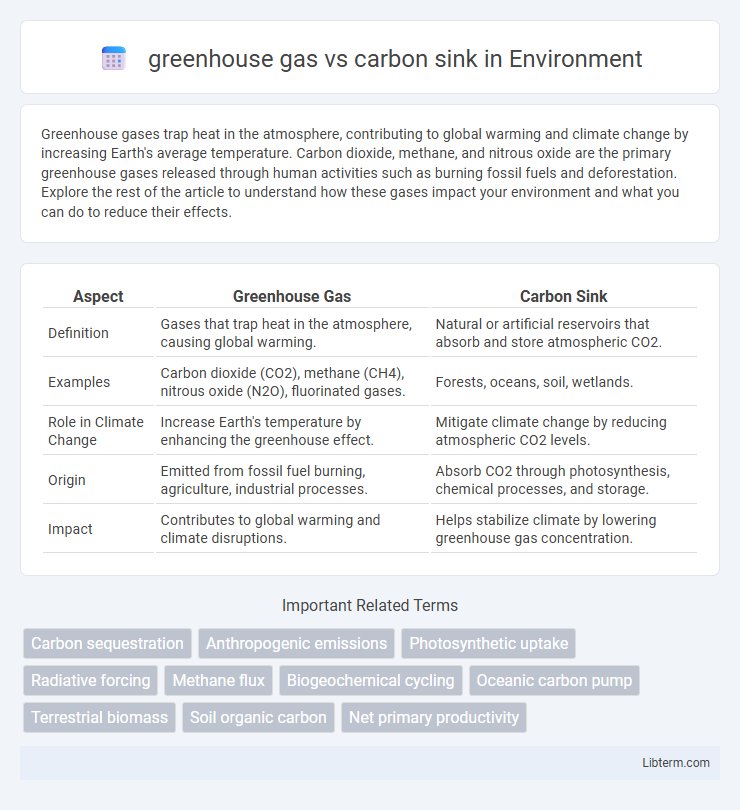Greenhouse gases trap heat in the atmosphere, contributing to global warming and climate change by increasing Earth's average temperature. Carbon dioxide, methane, and nitrous oxide are the primary greenhouse gases released through human activities such as burning fossil fuels and deforestation. Explore the rest of the article to understand how these gases impact your environment and what you can do to reduce their effects.
Table of Comparison
| Aspect | Greenhouse Gas | Carbon Sink |
|---|---|---|
| Definition | Gases that trap heat in the atmosphere, causing global warming. | Natural or artificial reservoirs that absorb and store atmospheric CO2. |
| Examples | Carbon dioxide (CO2), methane (CH4), nitrous oxide (N2O), fluorinated gases. | Forests, oceans, soil, wetlands. |
| Role in Climate Change | Increase Earth's temperature by enhancing the greenhouse effect. | Mitigate climate change by reducing atmospheric CO2 levels. |
| Origin | Emitted from fossil fuel burning, agriculture, industrial processes. | Absorb CO2 through photosynthesis, chemical processes, and storage. |
| Impact | Contributes to global warming and climate disruptions. | Helps stabilize climate by lowering greenhouse gas concentration. |
Understanding Greenhouse Gases: Definition and Types
Greenhouse gases (GHGs) such as carbon dioxide, methane, and nitrous oxide trap heat in the Earth's atmosphere, contributing to global warming and climate change. Carbon sinks refer to natural or artificial reservoirs, like forests, oceans, and soil, that absorb and store more carbon dioxide than they release, thus mitigating the effects of GHGs. Understanding the distinction between various greenhouse gases and the role of carbon sinks is crucial for developing effective climate policies and reducing atmospheric carbon concentrations.
Exploring the Concept of Carbon Sinks
Carbon sinks are natural or artificial reservoirs that absorb and store carbon dioxide from the atmosphere, playing a crucial role in mitigating greenhouse gas emissions. Forests, oceans, and soil act as significant carbon sinks by sequestering carbon, thus reducing the concentration of greenhouse gases that contribute to global warming. Enhancing the capacity of carbon sinks through reforestation, soil management, and ocean conservation is vital for balancing the carbon cycle and addressing climate change.
The Role of Greenhouse Gases in Climate Change
Greenhouse gases such as carbon dioxide, methane, and nitrous oxide trap heat in the Earth's atmosphere, driving global warming and climate change. Carbon sinks like forests, oceans, and soil absorb and store significant amounts of these gases, helping to offset emissions. The balance between greenhouse gas emissions and the capacity of carbon sinks determines the pace of climate change and informs mitigation strategies.
How Carbon Sinks Mitigate Global Warming
Carbon sinks such as forests, oceans, and soil absorb significant amounts of carbon dioxide, reducing the concentration of greenhouse gases in the atmosphere. By sequestering carbon, these natural reservoirs slow the rate of global warming and help stabilize Earth's climate. Enhancing carbon sink capacity through reforestation, afforestation, and soil management is essential for effective climate change mitigation strategies.
Sources and Emissions of Greenhouse Gases
Greenhouse gases such as carbon dioxide (CO2), methane (CH4), and nitrous oxide (N2O) primarily originate from fossil fuel combustion, deforestation, agriculture, and industrial processes, contributing significantly to global warming. Carbon sinks, including forests, oceans, and soil, absorb about 50% of anthropogenic CO2 emissions annually, mitigating the impact of these emissions on the atmosphere. Understanding the balance between greenhouse gas sources and carbon sinks is crucial for developing effective climate change mitigation strategies.
Major Types of Natural and Artificial Carbon Sinks
Major types of natural carbon sinks include forests, oceans, and soil, which absorb significant amounts of carbon dioxide through photosynthesis and chemical processes. Artificial carbon sinks primarily consist of carbon capture and storage (CCS) technologies and enhanced weathering methods that trap CO2 in underground reservoirs or convert it into stable minerals. Understanding the balance between greenhouse gas emissions and the capacity of these sinks is crucial for mitigating climate change and achieving carbon neutrality.
Greenhouse Gas Accumulation vs. Carbon Sequestration
Greenhouse gas accumulation refers to the increasing concentration of gases like carbon dioxide, methane, and nitrous oxide in the atmosphere, which trap heat and contribute to global warming. Carbon sequestration involves processes that capture and store atmospheric carbon dioxide in carbon sinks such as forests, soil, and oceans, reducing net greenhouse gas levels. Effective carbon sequestration helps mitigate climate change by balancing or offsetting greenhouse gas emissions from human activities.
Human Impact on Greenhouse Gas Levels and Carbon Sinks
Human activities, such as fossil fuel combustion, deforestation, and industrial processes, significantly increase greenhouse gas levels by releasing large amounts of CO2 and methane into the atmosphere. These elevated greenhouse gas concentrations reduce the capacity of natural carbon sinks, like forests, oceans, and soils, to absorb carbon effectively, thereby accelerating climate change. Preservation and restoration of carbon sinks, alongside reducing emissions, are critical strategies to mitigate human impact on global greenhouse gas levels.
Strategies to Reduce Greenhouse Gases and Enhance Carbon Sinks
Strategies to reduce greenhouse gases focus on cutting emissions from fossil fuels, industry, and agriculture through renewable energy adoption, energy efficiency, and sustainable farming practices. Enhancing carbon sinks involves afforestation, reforestation, and soil carbon sequestration to absorb and store atmospheric CO2 effectively. Integrating these approaches accelerates climate mitigation by balancing emissions reductions with natural carbon capture improvements.
Future Perspectives: Balancing Greenhouse Gas Emissions and Carbon Sink Capacity
Future perspectives emphasize enhancing carbon sink capacity through reforestation, soil carbon sequestration, and blue carbon ecosystems to offset rising greenhouse gas emissions. Emerging technologies like bioenergy with carbon capture and storage (BECCS) and direct air capture (DAC) are critical for achieving net-zero targets by removing atmospheric CO2. Effective policies integrating emissions reduction with carbon sink augmentation will determine global success in mitigating climate change impacts.
greenhouse gas Infographic

 libterm.com
libterm.com